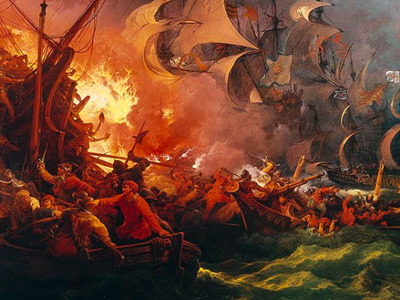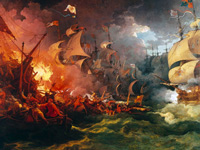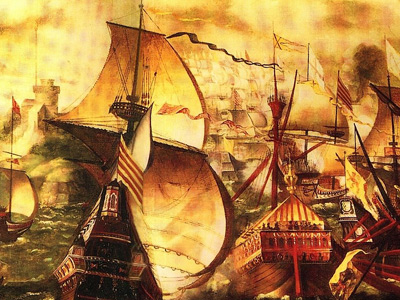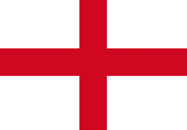Spanish Armada (1588)

Technological Revolution
The outcome vindicated the English naval battle strategy and resulted in a revolution in naval battle tactics of the era – using weather gage advantage and line-to-line cannon battle from windward (revealing the opponent ship's hull and rudder as targets) – with the promotion of heavier, more numerous naval cannon gunnery, which until then had played a supporting role to the principal tactics of ramming and crew boarding. The clear choice of sink or capture.

English ships and the Spanish Armada, August 1588

English ships and the Spanish Armada, August 1588
( Click image to enlarge)
Most military historians hold that the battle of Gravelines reflected a lasting shift in the balance of naval power in favour of the English The Kingdom of England was a sovereign state on the island of Great Britain from about 927, when it emerged from various Anglo-Saxon kingdoms, until 1 May 1707, when it united with Scotland to form the Kingdom of Great Britain. The Viking invasions of the 9th century upset the balance of power between the English kingdoms, and native Anglo-Saxon life in general. The English lands were unified in the 10th century in a reconquest completed by King Æthelstan in 927., in part because of the gap in naval technology and cannon armament it confirmed between the two nations, which continued into the next century. In the words of Geoffrey Parker, by 1588 "the capital ships of the Elizabethan navy constituted the most powerful battlefleet afloat anywhere in the world". The English navy yards were leaders in technical innovation, and the captains devised new battle formations and tactics. Parker argues that the sleeker full-rigged ship, amply cannoned, was one of the greatest technological advances of the century and permanently transformed naval warfare.
The Kingdom of England was a sovereign state on the island of Great Britain from about 927, when it emerged from various Anglo-Saxon kingdoms, until 1 May 1707, when it united with Scotland to form the Kingdom of Great Britain. The Viking invasions of the 9th century upset the balance of power between the English kingdoms, and native Anglo-Saxon life in general. The English lands were unified in the 10th century in a reconquest completed by King Æthelstan in 927., in part because of the gap in naval technology and cannon armament it confirmed between the two nations, which continued into the next century. In the words of Geoffrey Parker, by 1588 "the capital ships of the Elizabethan navy constituted the most powerful battlefleet afloat anywhere in the world". The English navy yards were leaders in technical innovation, and the captains devised new battle formations and tactics. Parker argues that the sleeker full-rigged ship, amply cannoned, was one of the greatest technological advances of the century and permanently transformed naval warfare.
English shipwrights introduced designs in 1573, first demonstrated in Dreadnought, that allowed the ships to sail faster and manoeuvre better and permitted heavier guns. Whereas before warships had tried to grapple with each other so that soldiers could board the enemy ship, now they more often stood off and fired broadsides that could sink the enemy vessel. Superior English ships and seamanship had foiled the invasion. The English also took advantage of Spain's overly complex strategy that required coordination between the invasion fleet and the Spanish army on shore. But the poor design of the Spanish cannon meant they were much slower in reloading in a close-range battle, allowing the English to take control. Spain The Spanish Empire was a colonial empire governed by Spain and its predecessor states between 1492 and 1976. One of the largest empires in history, it was the first to usher the European Age of Discovery and achieve a global scale, controlling vast territory. It was one of the most powerful empires of the early modern period, reaching its maximum extent in the 18th century. still had numerically larger fleets, but England was catching up.
The Spanish Empire was a colonial empire governed by Spain and its predecessor states between 1492 and 1976. One of the largest empires in history, it was the first to usher the European Age of Discovery and achieve a global scale, controlling vast territory. It was one of the most powerful empires of the early modern period, reaching its maximum extent in the 18th century. still had numerically larger fleets, but England was catching up.
HISTORY

RESOURCES
This article uses material from the Wikipedia article "Spanish Armada", which is released under the Creative Commons Attribution-Share-Alike License 3.0.
© Stories Preschool. All Rights Reserved.












